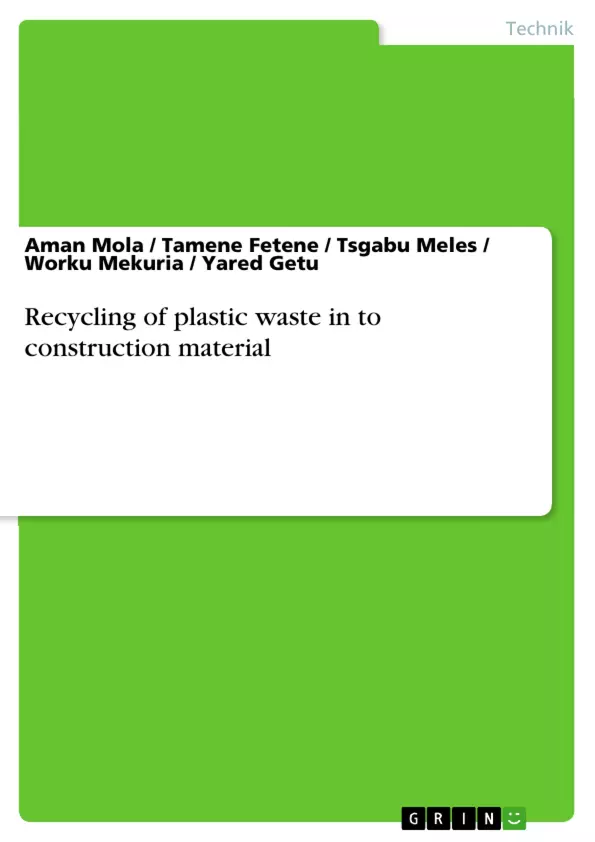As natural aggregate sources are becoming depleted due to high demand in construction industry and the amount of disposed waste material keeps increasing, researchers are exploring the use of alternative materials which good preserve natural resources and save the environment. In this study, the utilization of plastic waste and broken glasses as a construction material for the production of building construction inputs such as roof tile, floor tile and hollow plastic block is a partial solution to environmental and ecological problems. Quality control test of samples of prepared material are conducted and compared with the standard material specification This study implies that for hallow plastic block, 33% plastic, 11.17% fine glass, 11.17% fine sand and 44.6% glass gives an optimum compressive result and plastic waste with a ratio of 30% plastic waste. Using plastic waste with a ratio of 30% plastic waste and 70% glass and sand gives better and quality roof tile, and 32% plastic and 68% glass and sand is preferable for light traffic zone (axle load less than 27Mpa) floor tile. Finally, conclude that using plastic tile in humid (wet) environment is preferable because it can resist cold and freeze weather due to low water absorption.
Inhaltsverzeichnis
- Kapitel 1: Einleitung
- Kapitel 2: Literaturübersicht
- Kapitel 3: Methodik
- Kapitel 4: Ergebnisse
- Kapitel 5: Diskussion
Zielsetzung und Themenschwerpunkte
Die vorliegende Bachelorarbeit untersucht die Möglichkeit, Plastikabfälle und zerbrochenes Glas in Baumaterialien zu recyceln. Ziel ist es, die Machbarkeit und die Eigenschaften der daraus resultierenden Materialien zu erforschen.
- Recycling von Plastikabfällen
- Wiederverwendung von zerbrochenem Glas
- Eigenschaften des neuartigen Baumaterials
- Umweltfreundliche Baustoffproduktion
- Kosteneffizienz des Verfahrens
Zusammenfassung der Kapitel
Kapitel 1: Einleitung: Dieses Kapitel führt in das Thema der Arbeit ein und beschreibt die Problematik von Plastikabfällen und Bauschutt. Es erläutert die Notwendigkeit nachhaltiger Baustoffproduktion und die Motivation hinter der Untersuchung der Wiederverwertung von Plastik und Glas in Baumaterialien. Die Forschungsfrage und die Ziele der Arbeit werden klar definiert. Es wird ein Überblick über die Struktur der Arbeit gegeben.
Kapitel 2: Literaturübersicht: Dieses Kapitel bietet eine umfassende Übersicht über den aktuellen Stand der Forschung zum Recycling von Plastikabfällen und zerbrochenem Glas im Bauwesen. Es analysiert verschiedene Ansätze und Technologien, die bereits verwendet werden oder potentiell verwendet werden könnten. Die Kapitel analysiert die Vor- und Nachteile der bestehenden Methoden und identifiziert Forschungslücken, die die vorliegende Arbeit zu schließen versucht.
Kapitel 3: Methodik: Das Kapitel beschreibt detailliert die angewandte Methodik der Forschungsarbeit. Es erläutert die Auswahl der Materialien, die verwendeten Verfahren zur Herstellung der Baumaterialien aus recyceltem Plastik und Glas, und die Methoden zur Prüfung der Eigenschaften der neuen Materialien. Die verwendeten Messgeräte und Testverfahren werden präzise beschrieben, um die Reproduzierbarkeit der Ergebnisse zu gewährleisten.
Kapitel 4: Ergebnisse: Hier werden die Ergebnisse der durchgeführten Experimente und Tests präsentiert. Es werden detaillierte Daten und Messwerte zu den Eigenschaften der neu hergestellten Baumaterialien präsentiert und grafisch dargestellt. Die Ergebnisse werden nachvollziehbar und übersichtlich präsentiert, um den Leser ein klares Bild von den Eigenschaften des neuen Materials zu vermitteln.
Kapitel 5: Diskussion: In diesem Kapitel werden die Ergebnisse der Arbeit diskutiert und im Kontext des aktuellen Stands der Forschung eingeordnet. Es wird eine kritische Analyse der Ergebnisse durchgeführt, wobei auch mögliche Fehlerquellen und Limitationen der Studie berücksichtigt werden. Die Ergebnisse werden im Hinblick auf ihre Bedeutung für die nachhaltige Baustoffproduktion und die Abfallwirtschaft interpretiert. Die Schlussfolgerungen und Empfehlungen für zukünftige Forschung werden formuliert.
Schlüsselwörter
Recycling, Plastikabfälle, Glasrecycling, Baumaterialien, Nachhaltigkeit, Umweltfreundlichkeit, Materialeigenschaften, Baustoffproduktion, Abfallwirtschaft.
Häufig gestellte Fragen zur Bachelorarbeit: Recycling von Plastik und Glas in Baumaterialien
Was ist das Thema der Bachelorarbeit?
Die Bachelorarbeit untersucht die Möglichkeit, Plastikabfälle und zerbrochenes Glas in Baumaterialien zu recyceln. Das Ziel ist die Erforschung der Machbarkeit und Eigenschaften der daraus resultierenden Materialien.
Welche Kapitel umfasst die Arbeit?
Die Arbeit gliedert sich in fünf Kapitel: Einleitung, Literaturübersicht, Methodik, Ergebnisse und Diskussion.
Was wird in der Einleitung (Kapitel 1) behandelt?
Kapitel 1 führt in das Thema ein, beschreibt die Problematik von Plastikabfällen und Bauschutt, erläutert die Notwendigkeit nachhaltiger Baustoffproduktion, definiert die Forschungsfrage und Ziele und gibt einen Überblick über die Struktur der Arbeit.
Worüber informiert die Literaturübersicht (Kapitel 2)?
Kapitel 2 bietet eine umfassende Übersicht über den aktuellen Forschungsstand zum Recycling von Plastik und Glas im Bauwesen. Es analysiert verschiedene Ansätze und Technologien, deren Vor- und Nachteile und identifiziert Forschungslücken.
Welche Methodik wird in Kapitel 3 beschrieben?
Kapitel 3 beschreibt detailliert die angewandte Methodik: die Materialauswahl, die Verfahren zur Herstellung der Baumaterialien und die Methoden zur Prüfung der Materialeigenschaften inklusive der verwendeten Messgeräte und Testverfahren.
Was wird in Kapitel 4 (Ergebnisse) präsentiert?
Kapitel 4 präsentiert die Ergebnisse der Experimente und Tests mit detaillierten Daten und Messwerten zu den Eigenschaften der neu hergestellten Baumaterialien, grafisch dargestellt und nachvollziehbar präsentiert.
Wie werden die Ergebnisse in Kapitel 5 (Diskussion) behandelt?
Kapitel 5 diskutiert die Ergebnisse, ordnet sie im Kontext des aktuellen Forschungsstands ein, führt eine kritische Analyse durch (inkl. Fehlerquellen und Limitationen), interpretiert die Ergebnisse im Hinblick auf nachhaltige Baustoffproduktion und Abfallwirtschaft und formuliert Schlussfolgerungen und Empfehlungen für zukünftige Forschung.
Welche Schlüsselwörter sind relevant für die Arbeit?
Die Schlüsselwörter sind: Recycling, Plastikabfälle, Glasrecycling, Baumaterialien, Nachhaltigkeit, Umweltfreundlichkeit, Materialeigenschaften, Baustoffproduktion, Abfallwirtschaft.
Welche Zielsetzungen werden in der Arbeit verfolgt?
Die Arbeit zielt darauf ab, die Machbarkeit und Eigenschaften von Baumaterialien aus recyceltem Plastik und Glas zu erforschen. Konkrete Themen sind das Recycling von Plastikabfällen, die Wiederverwendung von zerbrochenem Glas, die Eigenschaften des neuen Baumaterials, umweltfreundliche Baustoffproduktion und die Kosteneffizienz des Verfahrens.
- Arbeit zitieren
- Aman Mola (Autor:in), Tamene Fetene (Autor:in), Tsgabu Meles (Autor:in), Worku Mekuria (Autor:in), Yared Getu (Autor:in), 2019, Recycling of plastic waste in to construction material, München, GRIN Verlag, https://www.grin.com/document/512889



